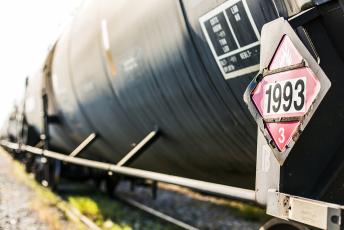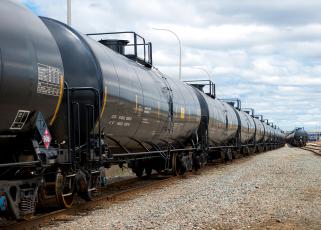Alongside the publication of AFPM’s new study, “The Fuel & Petrochemical Supply Chains: Moving the Fuels & Products That Power Progress,” Flash Point interviewed leaders working on U.S. midstream infrastructure issues. Today, we’re going to hear from Boyd Stephenson, senior vice president of government affairs and counsel at the National Tank Truck Carriers (NTTC) as part of our series highlighting the U.S. fuel and petrochemical supply chains. NTTC members specialize in the trucking of goods such as petroleum products, chemicals, gases, and wastes. The organization’s members are regulated by the EPA and the Department of Transportation’s Pipeline & Hazardous Materials Safety Administration.
AFPM: How did you get involved in the trucking industry?
Boyd Stephenson: It’s kind of a funny story. As I get ready to have my 15th college reunion, I’m quite fond of the fact that my 22-year-old self would have probably laughed you out of the room if you told him that I would have been involved in trucking. I went to work right out of college in the government affairs office of a little trucking company called United Parcel Service – maybe you’ve heard of them – and then from there, I moved over to the American Trucking Association. I found that hazardous material issues are particularly fascinating and oftentimes get overlooked, much like trucking issues in general. So, it’s sort of the redheaded stepchild of the redheaded stepchildren, and I really fell in love with an industry that has a lot of family businesses and folks that treat each other like siblings.
AFPM: Can you explain the role your members play in fuel and chemical transportation?
Stephenson: The tank truck industry is very involved on both the first and the last mile [of fuel and chemical transportation]. Any sort of hydraulic fracturing requires significant amounts of both sand and water, and our trucks are the ones that move that sand and water. So, we are very, very involved on that front. We’re also the ones that show up at the fuel racks at the end of the day to move things from the refinery to the gas station or to another distribution point for retail customers. We’re the first folks to touch your products and the last folks to touch them before they go to the consumer.
AFPM: What is your assessment of the current state of U.S. highway infrastructure? Is the trucking industry well positioned to assist in the U.S. energy renaissance?
Stephenson: I do think we have a place in that. The American Society of Civil Engineers 2017 report card on America’s infrastructure rated overall infrastructure a D plus, bridges a C plus, and roads a D. You can tell that the professionals dealing with these matters know that our infrastructure needs significant repair. I don’t think that’s news to anyone who’s driven on the highways any time in the last 10 to 15 years. The fact of the matter is we don’t really fund our highway maintenance the way we should, and that’s going to be a challenge in the fuel and petrochemical realm in a few different areas. The most obvious is basic funding for roads. The federal fuel tax is 18.5 cents per gallon on passenger cars and 24.4 cents on heavy diesel trucks, and those rates haven’t changed since 1993. Every year as inflation grows, the fuel tax, which is frozen at a specific rate, does less and less. That’s really challenging because it means that states and localities are trying to upgrade and maintain their roads with a flat amount of money that goes less far every year. In the oil and gas industry, there are even greater challenges – more on the extraction side than on the distribution side. At the end of the day, the products necessary for extraction are extremely heavy, and there are challenges on two areas. The first relates to bridges. We have a bridge formula that determines how much weight you can send over a particular bridge, and as they become more and more disrepaired, the amount of weight you can put on them falls lower and lower. This means that a lot of routes that could be serviced quickly by traveling over a bridge become infeasible because the trucks have to take another route or use a more recently serviced bridge. The other challenge is that a lot of the equipment necessary for transportation is oversized or overweight. We have a maximum weight allowed on trucks, but those can be exceeded with permits from states and localities. Obviously, those permits cost a significant amount of money, and that cost goes towards making sure that the roads are maintained to handle the extra weight that’s traveling over them. Why is that a challenge? Because as the normal highway funds are covering less and less, it means that states and localities are reaching out with these permits and charging more. As our infrastructure becomes less useful, it becomes more expensive on shippers and carriers. Ultimately, those costs get passed onto consumers in the form of higher gas prices.
AFPM: What infrastructure policy issues are most important to your membership? Are there any related policies that can impact highway transport?
Stephenson: A stable source of highway maintenance and repair funding is probably the most important issue for the trucking industry – historically, that was the gas tax. One thing to note about the gas tax is that it’s actually frozen from the rest of the federal budget, so that money lands in its own special bank account to pay for the roads. When you think about it, it makes a lot of sense because we use gasoline to travel on the roads and the tax on that gasoline to maintain and repair the roads. It’s very much a virtuous circle, but that fund is not keeping up with the needs these days. We’re not necessarily married to the idea of a gas tax or a gas tax increase, but we have to do something to stabilize that fund. State and local laws that get in the way of interstate commerce are also a challenge for our industry. Some of the most dangerous are when states and localities create laws that govern when drivers can operate and when they have to take breaks – we already have a federal regulator that does that. If you think about a trip through some of the smaller northeastern states, you can see how things get really challenging when you have one state – let’s say Pennsylvania – mandating a 45-minute break after you’ve been driving for two hours. But then you move over into Delaware and they say you have to take a one-hour break after you’ve been driving for three hours. Then in New Jersey, they say something completely different. These laws get conflictual, and they limit the amount of time the drivers are on the road which is a big headache for us. Ultimately, it means that it takes longer for goods to move from point to point. We have some similar issues when states and localities get in the way of trucks carrying hazardous materials, which include gasoline and other petroleum products. Again, we have a well-developed federal system there, and we really feel like we need to let it work. Finally, the trucking industry has a demographic problem. We’re going to need about 890,000 more truck drivers over the next 10 years to keep up with predicted demand. As many in transportation know, we already have a heavy driver shortage that can make it very difficult to procure economical transportation. We’d like to see steps taken that can bring more drivers into our industry because trucking is really challenged in that regard. Federal rules say that you can’t drive a truck in interstate commerce until you’re 21, and that’s a bit of a challenge because a lot of the folks that might perceivably become truck drivers would do so right after high school. Instead, they’re saying, “Well, I graduated, you know what, let me get into an apprenticeship to become an electrician or a plumber.” And then the truck driving schools come in a few years later and say, “I know you’ve put in all this time and effort and you’re on your way toward a well-paying career, but we’d like you to abandon all of that and learn how to drive a truck.” It’s just not a position that makes for a great stand in our workforce. At the same time, our workforce is aging. Our average driver is four years older than the average United States worker, and in the tank truck sector that’s even more exacerbated. The fact is that most carriers won’t let you transport hazardous materials until you’ve been driving for two years, and on top of that, most carriers won’t let you operate a tank until you’ve been transporting the hazardous materials for two years. That puts us in the position to get the best and the safest drivers, and I truly believe that the tank truck sector safety record speaks for itself, but a tighter labor market for drivers makes it harder for us to find them.
AFPM: Can you discuss how the trucking industry assists in times of need and what challenges are associated with those types of events?
Stephenson: The tank truck sector is very involved in response because, as the folks at FEMA will tell you, the number one goal in responding to any disaster is getting things up and running, getting the power restored and reenergizing the basic living infrastructure. The two main components you need for that are fuel and water, and natural disasters tend to disrupt the transportation of these two very important commodities. In the case of fuel, we’re generally worried about getting gasoline back into the affected region as quickly as possible. Oftentimes, especially when there’s an evacuation order, it means that there’s a run on gasoline, so you have to get gas there as quickly as possible. There’s also a significant amount of equipment – running on diesel generators – traveling into these affected areas, which means there’s a need for tank trucks. There are also similar issues with water, and this is an area where I have seen our drivers stand up and say, “How do we get involved?” I recommend looking into a group called the American Logistics Aid Network (ALAN). They essentially act as a non-profit broker, matching groups with donations to the destinations that need support and the transportation companies that can provide the carriage. The trucking industry at large is very pleased to be involved with ALAN because it’s one of the fastest ways to get things done. We’re also lucky to be moving into an era in which the states understand how to help us help them – Florida in the fall of 2017 is perhaps the best example of that. The roads were shut down and police escorts were there for our drivers who were moving things in and out as quickly as possible. Once you have that basic infrastructure in place, it’s amazing how quickly civilian populations can come in and get their lives back in order.


